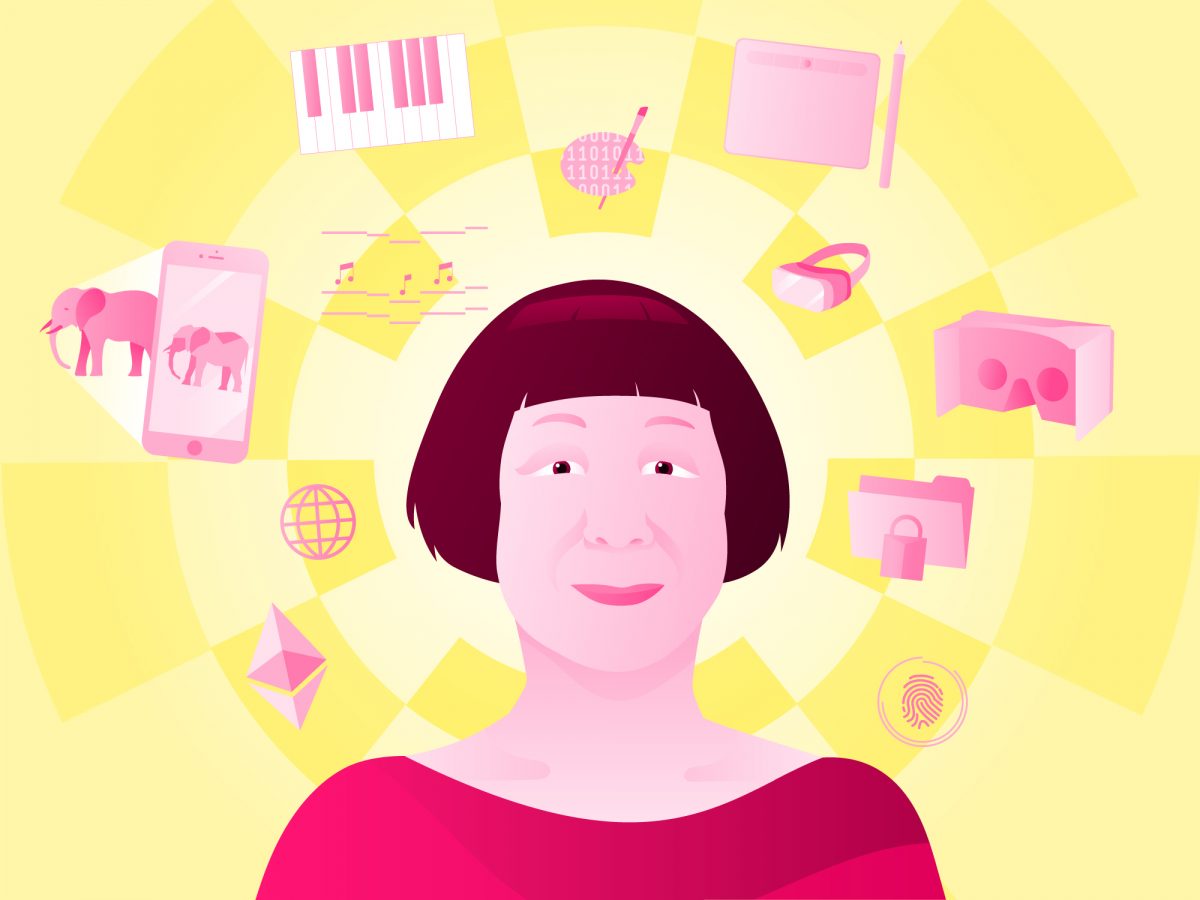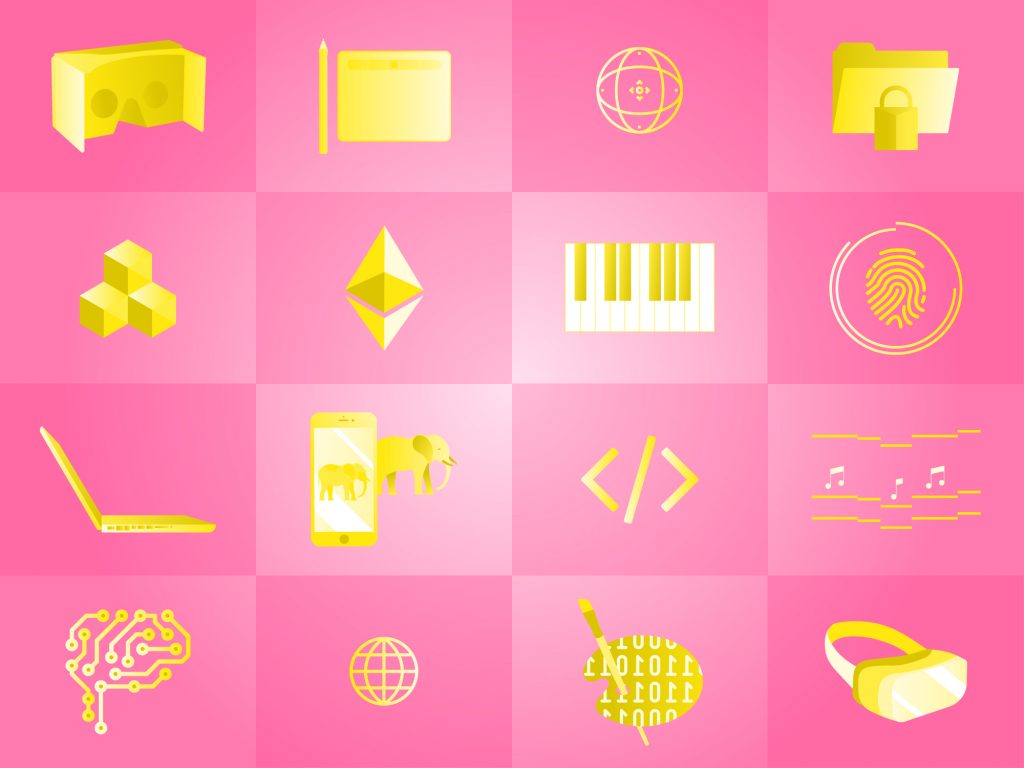
As part of Kaspersky’s Bring on the Future series, we meet people and businesses around the world who are changing the industry, and society, for the better.
Lin Hsin Hsin is the Founder and CTO of SpaceGraph. She’s an inventive technologist, artist, poet and composer from Singapore whose practice is deeply rooted in mathematics and information technology. In 1994, she established the Lin Hsin Hsin Art Museum – the first virtual museum in the world. I met Lin at a recent cybersecurity conference, and we discussed the connections between cyber-tech and art in her work.
Oleg: How did you become interested in cybersecurity?
Lin Hsin Hsin: Cybersecurity is a discipline I’m hugely interested in. I specialize in threat intelligence. I’m particularly interested in new encryption methods and emerging technologies like blockchain and biometrics. I like exploring smart contracts too – these are an integral part of cryptocurrencies but they’re not so ‘smart’ – they use weak programming language with flawed language design.
I think of cybersecurity as a ‘cat and mouse’ game between the cybercriminals and the security experts. Can we beat them?
Well said!
It isn’t a question of whether the experts or cybercriminals will win, it boils down to the prevalence of cybersecurity awareness.
Even more so at the enterprise level, incidents show that people are often the weakest link. All you need is a moment of lapsed attention and all your cautious preparation is rendered invalid.
On the other hand, enterprises are constantly battling with insider threats too. Is it possible to have a quantum leap in cybersecurity? Well, yes, the deployment of data science and advancements in artificial intelligence (AI) can propel us toward better solutions, but hackers are also using the same tools and processes to get ahead of the curve.
Recently you created a series of artworks around Brexit. Will you create more art based on political themes?
My Brexit Art Series consists of 50 digital artworks – it’s now complete. Why 50? Because of Article 50! I even created a markup language <BREXML> based on the term ‘Brexit.’
You invented the first 100 percent Directed Acyclic Graph (DAG) protocol, known as SpaceGraph, and you excel in using blockchain algorithms. What are your thoughts about using blockchain?
I was the first person in the world to author the phenomenon of cryptocurrency, back in 1996. To date, there are only two protocols in existence, Bitcoin and Ethereum. The rest are either platforms or apps.
The 10-year-old Bitcoin protocol is all about mining, where transactions are verified by peer-to-peer networking through cryptography and recorded in a public-distributed ledger called blockchain. Ethereum is a modified Bitcoin consensus via transaction-based state transitions.
In June 2016, Ethereum and ĐAO (the related decentralized autonomous organization) was exploited due to several security vulnerabilities associated with ĐAO’s smart contract software. It performed credible trackable, but irreversible, transactions without third parties to reduce transaction costs. Every transaction executed on Ethereum requires gas, defined as a fraction of an Ethereum token.
There was a time when people thought blockchain was immutable. Now people have realized a few 51% attacks (blockchain attacks) do exist.
Will these attacks persist? Yes, definitely. In May 2018, Bitcoin Gold – then the 26th-largest cryptocurrency – suffered a 51% attack. The malicious actor, who controlled a vast amount of Bitcoin Gold’s hashpower, was able to double spend for several days, eventually stealing 18 million US dollars worth of Bitcoin Gold.
More interestingly, it’s the 34% attack, via the tangle – a distributed ledger fundamentally distinct from a blockchain, but designed to achieve similar goals – that could be more of a risk. It’s called a ‘34% attack’ because it would take just 34 percent of network hashing power to carry out the attack.
You’re a pioneer in both the IT industry and digital art. How do you imagine the future of digital art?
We used to read physical copies of newspapers and books. How many people still have this habit? Book stores have converted to cafés for people to socialize, though most people are ordering a drink with their eyeballs glued to their mobile screen rather than interacting with another person!
Only a few things won’t go digital, like chicken rice and wine. In 1994, I built a digital toilet, complete with digital toilet paper and poems, inside my virtual museum. It attracted over one million visitors to its ‘throne.’
Will the advance of neuro-interfaces create artificial effects on our senses?
Yes, these already exist. Recently, I invented some shimmering art for your pleasure! SPARKLE (Shimmering Pixels Assimilated Resistive Touchscreen Kindle iLuminated Emissions) is my latest invention.
Will physical art survive?
If our senses can be activated and experienced digitally anytime, anywhere, why should we need the physical world?
Archiving art is a nightmare because its materials always degenerate. It needs a great deal of space and preservation.
Let me take you further on the journey. With the current capabilities of neuro-networks Generative Adversarial Network (GAN and deepGAN), the days of Hollywood’s rule are numbered! Do we even need actors, cameras or production crew?

I’m also a composer. I’ve recreated Western orchestral instruments from alternative sounds. For example, using the sound of water rippling, gushing and dripping, you can create the foundation of a sonic tone for a digital musical instrument. There’s no difference in building a cat’s meow or a dog’s bark from this digital instrument.
Don’t you think something would be lost in the process?
No! This is a replacement – there’s no loss. New art and art forms can be created by harnessing the inherent properties of digital, like the internet and smartphone.
I’m a huge admirer of the Bolshoi Ballet. The AI-assisted and sensor-based pointed shoes can be used to track a dancer’s movements, training the dancer’s skills to perfection. By measuring the dancer’s exact body, it’s also faster and better. Of course, robots could replace ballerinas very soon.
How have you used virtual reality (VR) in your art?
I started creating 3D art back in 1982. My first awareness of VR was in 1997, when I met the father of VRML (Virtual Reality Modeling Language), Mark Pesces, in Los Angeles, USA. I started making VR art two years later, the same year I exhibited my first 3D printing work. I was the first person in the world to successfully use equations to create 3D design for sculptures, objects and jewelry.
Fast-forward to 2011, I invented the first cardboard VR glass, three years before Google Cardboard!
There’s a lot of talk about digitization and tokenization in art, but people sometimes say viewing digitized art in cyberspace feels ‘fake’ and ‘bland.’ What’s your view?
Art was digitized about two decades ago! About the tokenization of art, I can’t see the benefits because you must first filter out all the fakes, and that in itself is a mammoth task! I’ve delivered lectures on fake art, both fake non-digital art as well as fake digital art.
Recently I created a method to make a digital canvas. It redefines the medium. If you use a physical bristle to draw an elephant on textured cloth or canvas, there will be two different impressions, so you will see two different elephants. I programmed a digital canvas to create this textured effect, to evoke a feeling. It’s designed to make you feel better, compared to seeing the image with the factory default settings. It’s like going to a concert hall to hear a concert and discussing the acoustics over a glass of wine in the intermission, compared to staying home and listening to the concert on your headphones. You’re the first person I’m sharing this concept with!
I’m delighted to hear about it! How do you see the future of utility tokens and cryptocurrency? Will the world adopt cryptocurrency as its preferred payment method?
In all countries, the function of a central bank is to exercise control of the country’s monetary system and policy. Central banks issue and regulate, limiting the circulation of the national currency. Other than security tokens and stable coins, cryptocurrency is decentralized and unregulated by financial policymakers, hence their objections to it.
But several countries, like Luxembourg, Malta and Marshall Islands, have endorsed and adopted cryptocurrencies as their sovereign and legal tender. As cryptography is anonymous, it eases peer-to-peer transactions and facilitates instant currency exchanges. It’s the rise of the truly ‘cashless society.’ It may even help to find solutions to debt.
That would be a game-changer. What’s your perspective on quantum computing?
Unlike the existing computing world, quantum computing is based on qubits – sub-atomic bits such as electrons or photons. In cryptocurrency, quantum computers can break the elliptic curve cryptography efficiently in the two existing protocols, Bitcoin and Ethereum.
Though not tested, it shouldn’t affect the third protocol, SpaceGraph™ that I architected in 2018. A quantum computer can calculate the private key from a signature, although it may not be as useful, as there’s no longer any credit on the address. In any case, it can also exercise powerful attacks on the RSA asymmetric key systems.
Art vs technology: How do you share these disciplines in your life?
There is no ‘art.’ I define ART as:
Art
Requires
Technology
Technology
Redefines
Art
What are your hopes for the future?
I’d like a future devoid of scams and fakes.
About a year ago, I was attending a tech event. When I was waiting for our (human-made) coffee, I met a man who asked me what I did for work.
I replied, “I’m an artist.”
He was shocked. “Why are you at a tech event? What else do you do?”
I replied, “Cybersecurity.”
He became more puzzled and asked, “What’s the connection?”
I said, “The logic is very simple: cybersecurity prevents the theft of my digital IP.”
Eradicating plagiarism, fakes and lies is important to my future as a digital artist, and for the world of technology.



